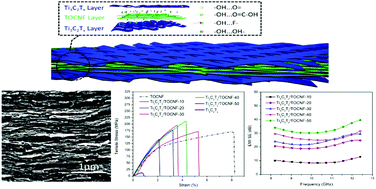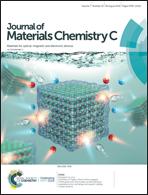Ultrastrong and conductive MXene/cellulose nanofiber films enhanced by hierarchical nano-architecture and interfacial interaction for flexible electromagnetic interference shielding†
Abstract
With the development of wearable and portable electronic devices, there is growing demand for ultrathin high-performance electromagnetic interference (EMI) materials with desirable mechanical properties. In this study, 2,2,6,6-tetramethyl-1-piperidinyloxy (TEMPO) oxidized cellulose nanofibers (TOCNFs) were used to fabricate ultrathin and flexible Ti3C2Tx/TOCNF composite films with a nacre-like layered structure via a simple vacuum-assisted assembly. These composite films present excellent mechanical strength (up to 212 MPa) and Young's modulus (up to 7 GPa) due to their strong intermolecular interaction and hierarchically aligned structure, which is superior to the state-of-the-art MXene-based functional materials. Furthermore, the Ti3C2Tx/TOCNF composite films exhibit high electrical conductivity (up to 2837 S m−1) and an outstanding EMI shielding effectiveness (SE) of 39.6 dB at a very low thickness of 38 μm. The possible synergistic mechanisms enhancing the mechanical properties and EMI shielding performance are discussed. The design and fabrication of Ti3C2Tx/TOCNF composite films provide a versatile strategy for ultrathin high-performance EMI shielding materials with desirable mechanical properties, which have great potential for various applications, especially in flexible, wearable and portable electronics.



 Please wait while we load your content...
Please wait while we load your content...